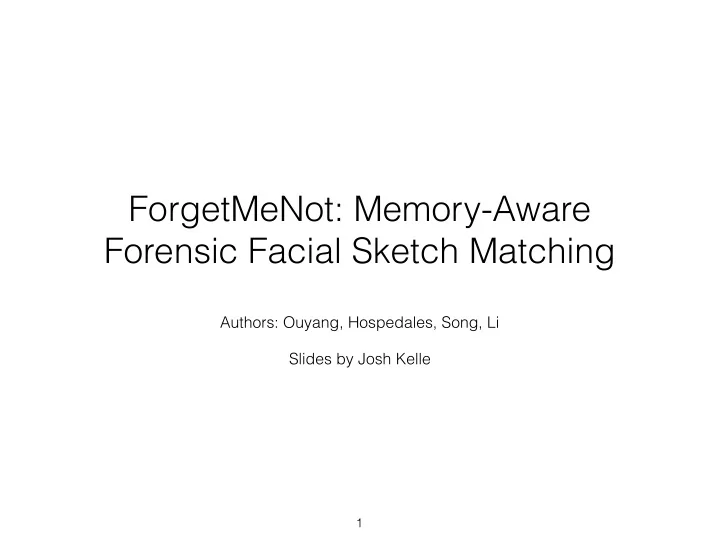

ForgetMeNot: Memory-Aware Forensic Facial Sketch Matching Authors: Ouyang, Hospedales, Song, Li Slides by Josh Kelle 1
Overview • VIPSL dataset • experiment goals • experiment results • conclusion 2
VIPSL Dataset artist A B C D E • Photographs of 200 faces with neutral expression • Each photo was sketched by 5 different artists 3
Artist Style Artist A Artist B 4
Goal: re-sketch in a different style Gaussian Process input output sketch from artist A sketch in the style of artist B 5
HOG representation Gaussian Process input HOG output HOG invert HOG input sketch features features features 6
Training the GP 2560 . • Treat each HOG image as a vector in ℝ 150 , although this didn’t produce a noticeable • Use PCA to reduce this to ℝ improvement. 150 → ℝ 150 • GP: ℝ 2560 hog space. • Then convert GP output back to ℝ X = { } Y = { } 7
Results for A → B model input GP prediction ground truth • The prediction’s gradients look less sharp, which is good. • I was surprised to see more gradients around the outside of the head. 8
Results for A → B model input GP prediction ground truth • It looks like the GP is smoothing too much. • Hypothesis: the GP is putting too much emphasis on the mean face. 9
Reverse direction: B to A A A to B GP AB A has more A has more gradient gradient activity than B activity than B GP BA B B to A 10
Quantifying Style Similarity • Measure similarity of sketch style by L2 distance in HOG space. where x i(A) is the HOG representation of the i-th sketch from artist A 11
Quantifying Style Similarity A → B A A B B prediction Lowest A → B error (err = 91) Highest A → B error (err = 176) 12
Which artists have similar style? A B C D E A and B are most different A 0 129.52 119.99 119.27 125.82 • For each pair of B 129.52 0 120.8 121.32 122.95 artists X → Y, measure average C 119.99 120.8 0 114.05 121.02 prediction error. D 119.27 121.32 114.05 0 104.03 D and E are E 125.82 122.95 121.02 104.03 0 most similar 13
Which artists have similar style? A B C D E A B C D E A 0 129.52 119.99 119.27 125.82 B 129.52 0 120.8 121.32 122.95 C 119.99 120.8 0 114.05 121.02 D 119.27 121.32 114.05 0 104.03 E 125.82 122.95 121.02 104.03 0 14
Chaining … GP AB GP BC input sketch reconstructed sketch reconstructed sketch from artist A in the style of artist B in the style of artist C 15
Chaining • Does chaining reduce error? chaining did not improve • Average E → C error is 121. • avg_err(E → D) = 104 average avg_err(D → C) = 114 chaining improved • Compare error between E → C vs E → D → C chain. test set index 16
Chaining • Does chaining reduce error? chaining did not improve • Average E → C error is 121. • avg_err(E → D) = 104 average avg_err(D → C) = 114 chaining improved • Compare error between E → C vs E → D → C chain. test set index 17
Chaining (best and worst case example) E D C chaining improved the most chaining improved the least 18
Chaining (best test case example) E → D → C E → C 19
Chaining (worst test case example) E → D → C E → C 20
Chaining • Differences are too slight to see a difference in HOG images. • Error is ~ 100. Difference in error ~3. Most extreme gains and losses are only about 3% different. • I’m not convinced chaining significantly improves results. 21
Conclusions • Gaussian Processes can be used to learn the relation between sketch images. • It’s not perfect. More data or a different feature space may help. • The authors’ use of multi-task learning helped alleviate the problem of small data. 22
Recommend
More recommend